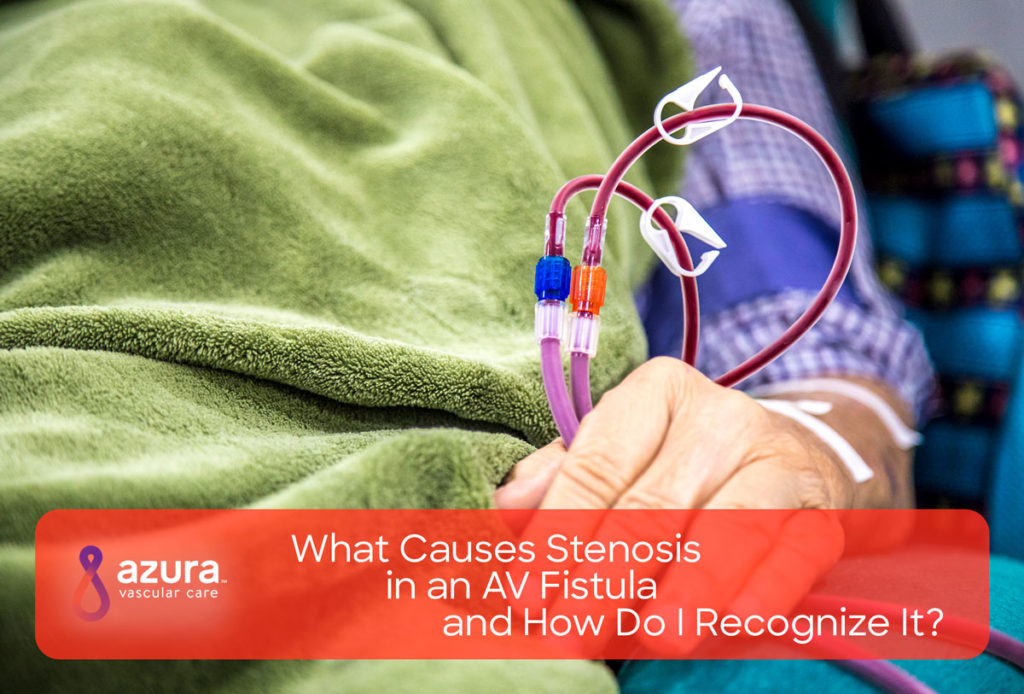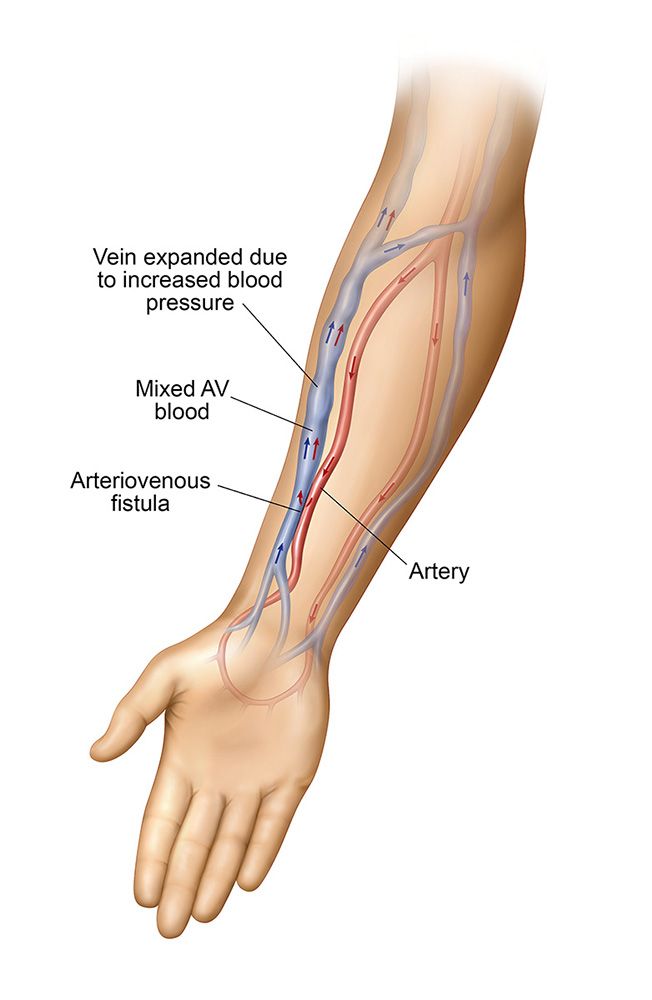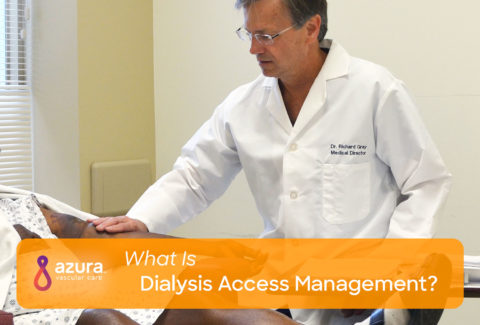
Stenosis is the number one cause of dysfunction in an arteriovenous (AV) fistula. (i) Evidence suggests that stenosis causes 78 percent of all cases of early AV fistula failure and is also the most common cause of late AV fistula failure after three months. (i) When left untreated, stenosis in a hemodialysis access can lead to the formation of a blood clot, also known as thrombosis. The risk of stenosis can be minimized by properly caring for your dialysis access and receiving quality dialysis access care.
If you or a loved one has an AV fistula, keep reading to learn more about what causes stenosis and how to recognize the onset of this medical condition.

What Is Stenosis?
The abnormal narrowing of a blood vessel is called stenosis. Stenosis slows and reduces blood flow through your AV fistula, causing problems with the quality of your dialysis treatment, prolonged bleeding after puncture, or pain in the fistula. Stenosis can also lead to a blocked or clotted access.
Stenosis tends to be more common with AV fistulas and AV grafts, but can occur with other types of dialysis accesses, too. This condition usually develops gradually over time. Being aware of the factors that cause stenosis can help your access remain healthy.
What Causes Stenosis in an AV Fistula?
When a vein and an artery are connected to form an AV fistula, the vein is at risk for damage caused by the change in blood flow rate and pressure from the high pressure, high flow rate in the arterial system. Your body responds to this damage by sending extra cells to repair the problem. Those extra cells build up over time resulting in stenosis. This abnormal narrowing can occur any place within the access but most often occurs at the anastomosis (the site where the artery and vein are connected). (ii)
The cause of stenosis soon after access creation is most likely related to an inadequate or insufficient vein, and/or artery selection. However, this may be prevented with vessel mapping prior to access creation, which uses Doppler ultrasound to evaluate blood vessels the surgeon selects for access creation. (iii)
Intimal hyperplasia is one of the primary causes of stenosis. This condition is characterized by the thickening of the innermost layer of the vein in response to trauma to the vessel, such as a complication of endarterectomy or reconstructive surgery. (iv)
Another cause of stenosis in an AV fistula is repeated punctures on your skin at the same location on the dialysis access. Scar tissue can form due to medical procedures involving blood pressure readings, intravenous (IV) lines, blood draws, and repeated hemodialysis cannulation in the same area of your fistula. (ii)
How Can I Recognize Stenosis in my AV Fistula?
Signs of stenosis may include:
- Bleeding from your access for longer than 20 minutes after your dialysis session has ended.
- Feeling a change in the thrill in your AV fistula or graft. (ii)
- Changes in the bruit, or sound of blood flow in your AV fistula or graft.
- Excessive alarms (high or low venous pressure alarms) on the dialysis machine due to access flow issues through the access during dialysis sessions.
Contact your dialysis care team immediately if you experience any of the above signs and symptoms of stenosis. Appropriate and timely treatment can minimize the progression of stenosis to thrombosis.
What Can I Do About Stenosis?
Maintaining the health of your AV fistula can also help minimize your likelihood of developing stenosis and prevent it from progressing and becoming worse.
Protect your access arm. Don’t allow anyone to take blood pressure readings in your arm that has the dialysis access, and don’t allow anyone to start an IV or draw blood from the limb in which your dialysis access is placed. This can cut down tremendously on scarring and may help reduce your risk for stenosis. If using an AV fistula or graft, make sure the sites where the needles are inserted are rotated. This will help prolong the life of your dialysis access.
The dialysis staff is experienced and knows about normal and abnormal function. At each dialysis session, your dialysis care team will closely examine your access site for possible signs of stenosis.
How Is Stenosis Treated?
Stenosis in a dialysis access can be treated by a vascular specialist in one of several ways based on the cause of your stenosis. Angioplasty is a common stenosis treatment that can widen your narrowed blood vessel. Angioplasty is a minimally invasive procedure in which a tiny balloon-tipped catheter is inserted into the affected blood vessel and inflated to widen the vessel which will allow for better blood flow. (vi)
Stenosis may also be treated with stent implantation, where a stent is permanently placed into the stenotic section of the affected blood vessel. (vi) A stent is a wire, mesh scaffold that helps your blood vessel remain open after the angioplasty. If your stenosis was caused by the surgical placement of your AV fistula, a vascular surgeon may perform revision surgery to correct the access.
A vascular specialist or your dialysis care team can educate you about stenosis and help you reduce your risk. Azura Vascular Care can also help you to recognize stenosis and is devoted to helping you fully understand how to properly care for your dialysis access. To find the Azura center nearest you, visit our center directory.
Sources:
(i) Campos, R.P., Nascimento, M.M., Chula, D.C., Nascimento, D.E., & Riella, M.C. (2006). Stenosis in hemodialysis arteriovenous fistula: Evaluation and treatment. Hemodialysis International, 10(2), 152-161. doi:10.1111/j.1542-4758.2006.00087.
(ii) Kidney School. (n.d.). Module 8—Vascular access: A lifeline for dialysis. Retrieved February 18, 2019, from https://www.kidneyschool.org/m08/18/.
(iii) University of California San Francisco Department of Surgery. (2018). Vascular Access for Hemodialysis. Retrieved April 16, 2019, from https://surgery.ucsf.edu/conditions–procedures/vascular-access-for-hemodialysis.aspx.
(iv) Cheung, et al. (2017, October). Intimal Hyperplasia, Stenosis, and Arteriovenous Fistula Maturation Failure in the Hemodialysis Fistula Maturation Study. Journal of the American Society of Nephrology, 28 (10), 3005-3013; DOI: https://doi.org/10.1681/ASN.2016121355
(v) Mehta, H.J. (2017, Nov-Dec). Central Venous Stenosis: What Should a Nephrologist Know? Indian Journal of Nephrology, 27(6): 427–429. doi: 10.4103/0971-4065.202825
(vi) Vascular Access Society. (n.d.). Treatment of stenosis and thrombosis in AV fistulae and AV grafts. Retrieved February 18, 2019, from https://www.vascularaccesssociety.com/resources/media/Guidelines/7_treatment_of_stenosis_and_thrombosis_in_av_fistulae_and_av_grafts.pdf.


